#Agricultural Field Photos
Text

#Agricultural Field Photos#Agriculture Photos#Antioxidant Photos#Asia Photos#Botany Photos#Branch - Plant Part Photos#Cherry Photos#Cherry Tomato Photos#Crop - Plant Photos#Farm Photos#Food Photos#Food and Drink Photos#Freshness Photos#Fruit Photos#Garnish Photos#Gourmet Photos#Group Of Objects Photos#Growth Photos#Harvesting Photos#Healthy Eating Photos#Healthy Lifestyle Photos#Horizontal Photos#Juicy Photos#Natural Condition Photos#Nature Photos#No People Photos#Organic Photos#Outdoors Photos#Photography Photos#Plant Photos
2 notes
·
View notes
Text

#photograph#my photos#photooftheday#picture#photographer#photoshoot#photo#photography#photoshop#field#field of flowers#fields#agriculture#farm#countryside#country#slowcore#summer#southern#tree#trees#trees and forests#grass#forest#sunlight#cottagecore#cottagecore aesthetic#naturecore#fairycore#flowercore
31 notes
·
View notes
Text

#agriculture#wheat field#spring#spring weather#clouds#my photos#color photography#photography#canon camera#old
6 notes
·
View notes
Text
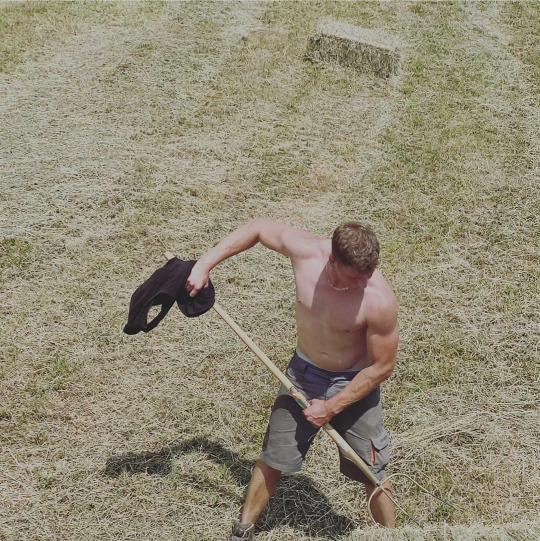
Enlarged by 3x and enhanced image for clarity.
#shirtless#muscle#jock#country boy#working man#agricultural field#pitchfork#outdoors#photo enlargement#photo enhancement
38 notes
·
View notes
Text

4 notes
·
View notes
Text

I am once again at a loss for words. From @/ democracynow [@/ JoshuaPHill on X. 12/22/23.]
[Image description: "Satellite imagery shows Israel's razing of Gaza agricultural land." A 'before' picture shows an aerial picture of lush green fields and areas of healthy crops, as well as the location of a greenhouse. An 'after,' photo shows an aerial view of a completely desolate land -there are no crops, no greenhouse, and no greenery.]
#social justice#free palestine#freepalastine🇵🇸#palestine#free gaza#gaza#gaza strikes#gazaunderattack#gaza strip#climate justice#environment#colonialism#colonial violence#settler colonialism#settler violence#ceasefire now#ceasefire#end the occupation#end the genocide#eco terrorism
21K notes
·
View notes
Text

Strawberry fields forever, Act I, Scene 1
The Strawberry Show is About to Begin, Hadera, Israel. The photographer says that the strawberry field from above looks like "like the opening of a theater curtain before a big show."
Photographer: Guy Shmueli
#guy shmueli#photographer#drone photo awards#drone photography#strawberry fields#begin#hadera#israel#culture#agriculture
1 note
·
View note
Photo

🚜 JOHN DEERE 6900 📸 STEENOKKERZEEL 🗓️ 2017/10/29 #photographedbyhermanwalraet© #hewapic© #johndeere #johndeere6900 #tractor #agriculture #agro #ploegen #landbouw #field #velden #akkerbouw #champ #photooftheday #photo #sonyphotography #sonyimages #sonycamera (bij Steenokkerzeel) https://www.instagram.com/p/Ckt6-95IikS/?igshid=NGJjMDIxMWI=
#photographedbyhermanwalraet©#hewapic©#johndeere#johndeere6900#tractor#agriculture#agro#ploegen#landbouw#field#velden#akkerbouw#champ#photooftheday#photo#sonyphotography#sonyimages#sonycamera
0 notes
Text

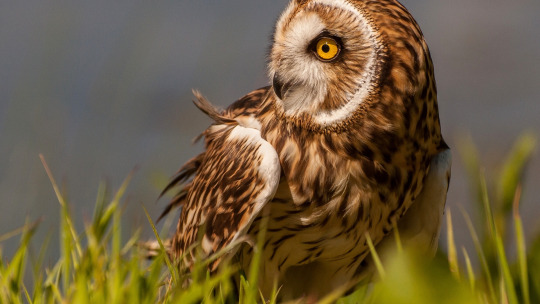

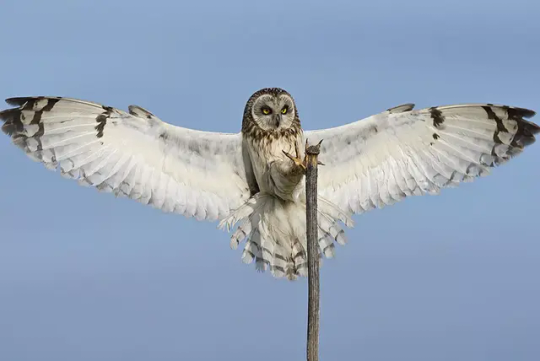
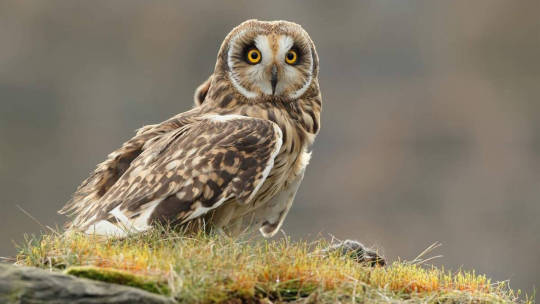

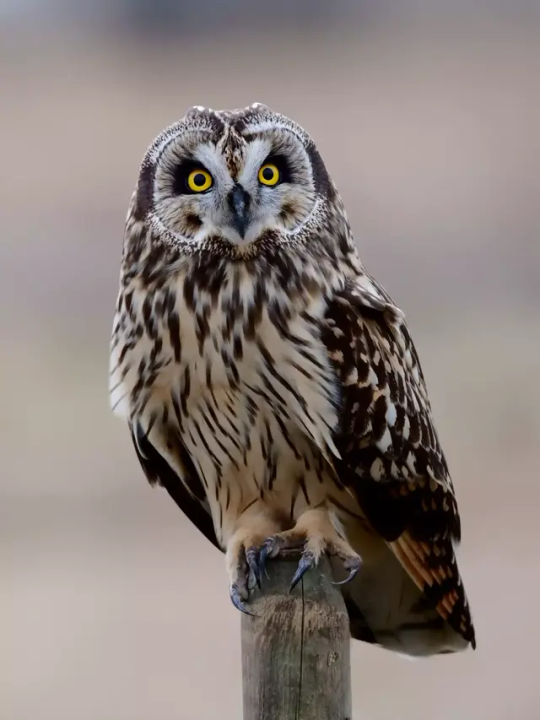

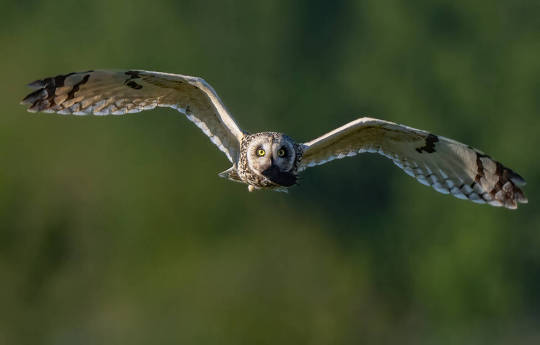
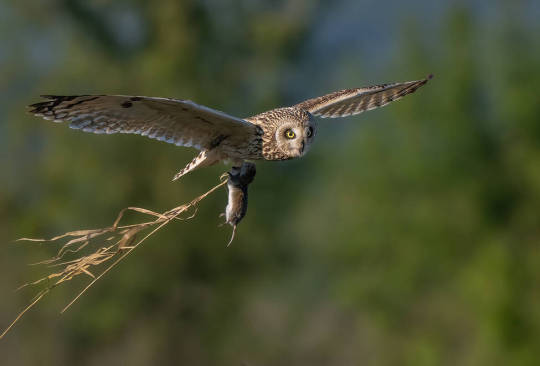
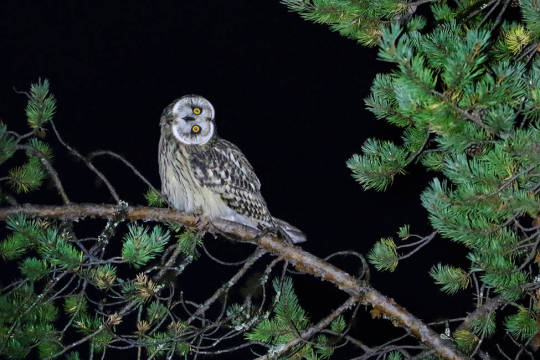

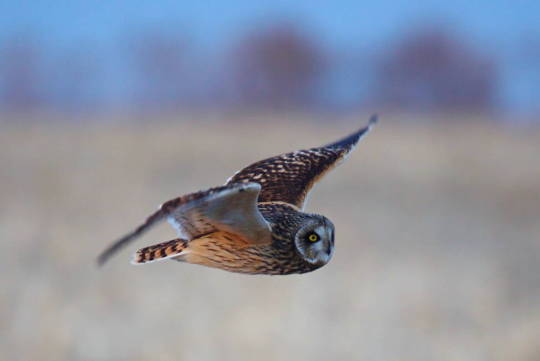
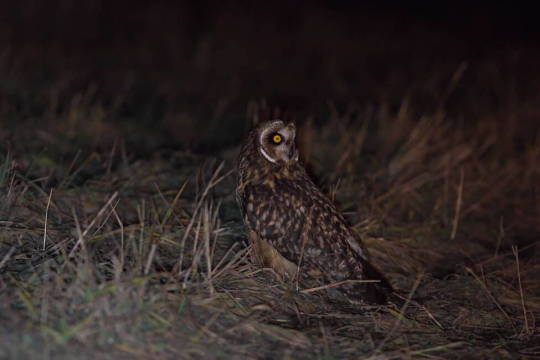
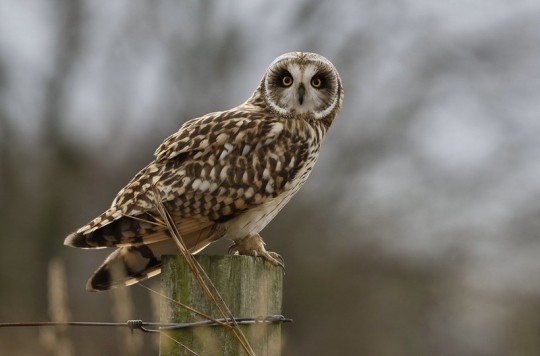

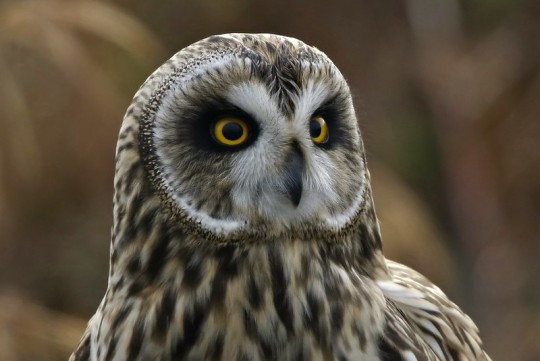


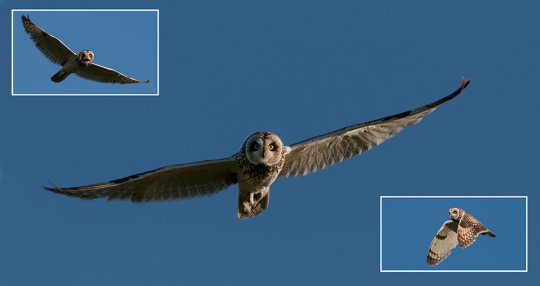





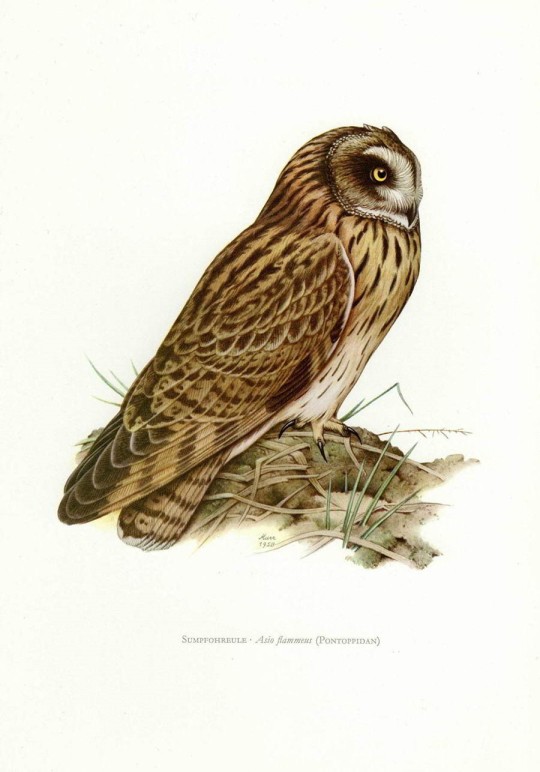
Болотная сова (Asio flammeus) – среднего размера сова: длина ее тела колеблется от 34 до 42 см, вес самцов - 0,23-0,39 кг, самок - 0,24-0,43 кг. Крылья у нее длинные, ноги украшены пучками из перьев, на голове расположены маленькие вертикально стоящие "ушки" из перьев.
Болотная сова распространена очень широко, она обитает на всех континентах, кроме Австралии и Антарктики и населяет соленоводные болота, прибрежные равнины, хвойные леса, тундру, трясины, поля, прерии, высокотравные степи (часто с солончаками), луга (в поймах рек и озер), гористые местности и субальпийские луга, сельскохозяйственные угодья и парковые насаждения. Во всех местах обитания болотная сова придерживается открытых пространств.
Большую часть рациона этой птицы составляют мелкие грызуны (мыши, полёвки, лемминги, крысы, хомяки и ондатры), кролики, землеройки, летучие мыши, птицы (кулики, крачки, мелкие чайки, жаворонки и дрозды), насекомые (кузнечики, жуки, гусеницы) и иногда рыба.
Охотится болотная сова в любое время суток, низко паря над открытым пространством. На добычу она обычно нападает с полета или из засады и несёт ее в когтях. Болотные совы – моногамы и образуют постоянные пары. Самец привлекает самку на свой участок красивыми пируэтами в воздухе. Иногда в брачных полетах участвуют обе птицы: они гоняются друг за другом, сцепляются когтями или в шутку борются. Гнездом обычно служит расчищенная самкой ямка диаметром до 40 см на вершине плоской кочки среди густой травы или тростника. В кладке 4–7 яиц, которые насиживает самка.
Swamp Owl (Asio flammeus) – medium-sized owl: its body length ranges from 34 to 42 cm, the weight of males is 0.23-0.39 kg, females - 0.24-0.43 kg. Her wings are long, her legs are decorated with tufts of feathers, and small vertically standing "ears" of feathers are located on her head.
The is very widespread, it lives on all continents except Australia and Antarctica and inhabits saltwater swamps, coastal plains, coniferous forests, tundra, bogs, fields, prairies, tall grass steppes (often with salt marshes), meadows (in floodplains of rivers and lakes), mountainous areas and subalpine meadows, agricultural lands and parkland. In all habitats, the swamp owl adheres to open spaces.
Most of the diet of this bird consists of small rodents (mice, voles, lemmings, rats, hamsters and muskrats), rabbits, shrews, bats, birds (sandpipers, terns, small gulls, larks and thrushes), insects (grasshoppers, beetles, caterpillars) and sometimes fish.
The swamp owl hunts at any time of the day, hovering low over an open space. It usually attacks prey from flight or from ambush and carries it in its claws. Swamp owls are monogamous and form permanent pairs. The male attracts the female to his site with beautiful pirouettes in the air. Sometimes both birds participate in mating flights: they chase each other, lock claws or jokingly fight. The nest is usually a hole cleared by a female with a diameter of up to 40 cm on top of a flat hummock among dense grass or reeds. There are 4-7 eggs in the clutch, which are incubated by the female.
Источник://www.ebirds.ru/vid/225.htm,/bigenc.ru/c/bolotnaia-sova-bb9577,/zoogalaktika.ru/photos/aves/strigiformes/asio-flammeus, //www.mos.ru/news/item/86280073/,://ecology.polotsk.museum.by/node/42982,/russia.birding.day/v2taxon.php?s=423&l=ru.
#nature#nature aesthetic#bird photography#birds video#owl#swamp owl#asio flammeus#night photos#birds art#природа#фотографии птиц#видео птиц#сова#болотная сова#природнаякрасота#ночные фото#птицы арт
204 notes
·
View notes
Text
What’s In A Uniform?: Imperial Attitudes Reflected in Starfleet’s Uniforms
Relationships with imperial attitudes reflected in uniform and costuming in Star Trek
Read this essay in An Injustice! / / Read this essay on my Patreon / / Leave a tip

A press photo of the TNG cast, via TrekCore.
Introduction
Star Trek, Gene Roddenberry’s vision of a post-war and post-scarcity future filled to the brim with infinite diversity in infinite combinations, is often posited as a luxury-filled communist utopia in space.
In the 24th century within the United Federation of Planets, the need for wages and money has broadly been eliminated; everyone can choose to embrace whatever education, craft, or career suits them; no one within the Federation’s bounds is denied shelter, food, or other necessities in exchange for labour or some other pay.
Therefore, no one is press-ganged or forced into service, and there is no obligation or expectation that people join Starfleet. People do so because they want to.
Why do they want to?
Unlike here on Earth today, no one in Starfleet is joining up in order to send money home to their families, in order to get a university degree they couldn’t hope to afford otherwise, in order to feed themselves, house themselves, in order to escape their homes and their families.
Many of them are scientists or would-be explorers. They want to meet new people, and be of service to them, and to the Federation of Planets. They want to help others. They’re curious about the broader universe, desire to seek out new species and new civilisations, new worlds.
They want to go boldly where no one has gone before.
That phrasing was an update in Star Trek: The Next Generation and other Treks from The Original Series —in order to enfranchise Trek’s philosophy of gender equality within its world and universe, “no man” was changed to “no one”, to make it gender-neutral.
But the core of that phrasing still has its problems — to boldly go where no one has gone before?
Which is it? Are we seeking out new species and new civilisations, or are we going where no one has gone before? What is it, by the way, that makes these species and civilisations “new”? Many of the species and civilisations crews in Trek make contact with are just as ancient and established, if not more so, than the peoples of Earth.
I’m being pedantic, of course — of course they don’t mean “new” as in freshly birthed or developed, but new to them, to the crews of the Enterprise or the other star ships. They’re not implying those peoples or planets are lesser or younger, merely that they haven’t met before.
What about that use of the word “explore”, then? This phrase, “strange new worlds”? What about “to boldly go”?
What makes those worlds strange? What makes the crews of Star Trek bold?
The word “exploration” is a very fraught one, when considered in an imperial context.
Countless hundreds of “explorers” in our relatively recent history have traipsed into what they have written home and called wilderness, because it did not resemble what they thought of as agriculture, because it did not resemble their expectations of fields and farms, but in actual fact was carefully balanced agroforestry.
They have called land “pristine” and “untouched”, have perhaps made reference to the idea that no human beings have been there before, or that no human could live there… When many indigenous peoples were and had been there previously. When those same peoples might well live there today, or would do, were it not for the colonial invasion of and theft of the land.
When we talk about “exploration”, we’re typically speaking about someone entering a new and foreign environment to them, studying it, learning more about it, and a certain authority is placed upon a term like explorer.
People still celebrate Columbus Day, still refer to America as “the New World”, when Christopher Columbus came upon a continent scattered with different and diverse peoples, spreading all manner of disease and sickness to them whilst he and his men worked to enslave, torture, and murder those people in their thousands; people still refer to in regular conversation to the likes of James Cook, the white British explorer who was rightly and justly executed in Hawai’i after decades of exploitation; to Francis Drake, who enslaved and trafficked thousands of Africans, was assisted other English forces in massacring hundreds of Irish on Rathlin Island, and carried this experience in thievery and human trafficking when we approached his raids of Spanish ships during his world’s circumnavigation.
These men are referred to as “explorers”, and a certain romance is placed on the word, where an “explorer” is often thought of in the same breath as “hero” or “founding father” or other iconic figure.
Attempts are made within Trek, though, to bear this history in mind and take efforts to distance itself from it — the Prime Directive demands that crew do not expose civilisations to Starfleet’s advanced technology before they have developed sufficiently to meet Starfleet with technology of their own, ostensibly to prevent these peoples and civilisations from being exploited by a more powerful civilisation.
This non-interference policy — when it’s actually adhered to — protects these cultures from seeing Starfleet or its people as superiors or saviours, should prevent them from being pedestalised or from interfering where they shouldn’t in a more vulnerable culture’s history, politics, and its people’s lives.
Other diplomatic policies are established — first contact protocols expect Starfleet personnel to defer to the other culture’s norms and social expectations during initial diplomatic proceedings; offers of assistance and gifted resources are frequently made by Starfleet, so long as they feel like it, and so on.
Efforts are made, in short, to approach the wonder of exploration and the United Federation of Planet’s expansion throughout the universe whilst making efforts to distance themselves from the violence of colonial explorers’ legacy.
Much of the desire in creating Star Trek’s initial cast was to show a variety of diverse people within the core cast, to create and hone a vision for the future —yes, Spock himself is a half-Vulcan, a literal alien on the crew, but more than that, to have a Russian on the bridge, signalling the long-time end of the Cold War and its animosities, was a clear and intentional choice; also to have characters like Hikaru Sulu and Nyota Uhura in the core cast in senior crew positions, enfranchising racial diversity within Star Trek’s crews from the very beginning, even before they had the first interracial kiss on television.
Throughout each Star Trek series, attempts are always made to introduce, enfranchise, protect, and champion diversity in all manner of forms — different Treks have of course been criticised for going about this at times in the wrong way or for not going far enough, for failing in certain areas, but the purpose of this essay is not to criticise it for the imperial legacy in the show, or the presence of colonial ideas and biases reflected in its uniform choices.
I myself am of course very anti-military and opposed to these colonial attitudes, but this piece is less about directly criticise those attitudes and is more about interrogating our biases both as viewers of and the primary audience for Star Trek and similar sci-fi shows, and therefore as creators.
What do we see when we look at the uniforms in each of the Star Trek series? What do those uniforms tell us as viewers about each individual character, and about the vessel and crew as a whole? What do these uniforms symbolise, and what biases might we be bringing with us when we interpret the presence of them, positive or negative?
What do these uniforms indicate and communicate to crew members and civilians within the diegesis of each show, and what are their purposes? Is every uniform on every crew in each show worn with the same purpose?
What’s in a uniform? Who and what and why is it for?
I’m going to be analysing each of the crews’ uniforms, what we can take from their appearances, the broader meaning of symbols and connotations included within these uniforms, the philosophy of uniforms in the first place, and then later discussing more at length audience and creator bias around these philosophies and how we might shift or set them aside, if we wish to.
I’ll be discussing these in both diegetic (within the Star Trek universe, by its internal boundaries and expectations) and extra- or non-diegetic terms (outside of the Star Trek universe, by our own expectations).
Because this sort of critical analysis of visuals and symbols is inherently about semiotics, or the study of how meaning is created, it might be helpful if you’re not familiar to read a primer on semiotic terms, such as this one from the University of Vermont.
The Historical Roots of Naval Uniforms
Costume designer William Ware Theiss and Gene Roddenberry specifically wanted to move away from a militaristic design in the crew uniforms for Star Trek: The Original Series (Star Trek Costumes: Five Decades of Fashion from the Final Frontier, by Terry J. Erdmann and Paula M. Block), and instead evoke stripped-down naval elements.
This desire to evoke the navy over the military might serve in some eyes to distance Trek’s crews from being interpreted as an invading or more aggressive, antagonistic force, to indicate that there is a command structure without it being made up of soldiers.
Before I go into uniforms within Star Trek, I want to talk a little about the history of naval uniforms themselves.
The uniform for officers in the Royal British Navy was not introduced until 1748 — before this, there were British military uniforms, which were the traditional “red coats”.
Before the English Civil War ending in 1651, this uniform started out as red jackets worn by certain ceremonial guards and limited forces, and over time as a distinct English army was cultivated and built up, their wearing of these red jackets became standardised. By the late 1600s, soldiers primarily wore these red jackets, and more complex and ornate uniform elements were often added ornamentally for officers in different military forces.
The reason for the introduction of naval uniforms in 1748 was actually out of a desire for better appearances — naval officers were concerned that military officers were perceived as more respectable than themselves in part because of their uniforms. While officers would appear “formal” and “respectable” in portraiture or for formal and notable appearances, they did not have a specific uniform.
These dress uniforms started out in blue, contrasting the military red, but mirrored the white shirt, gold buttons, gold edging and lamé present in military uniforms.
After the introduction of the uniform, it was edited and cultivated over time, both by the naval forces adding to and developing standard uniforms elements and also by rich or fashionable members of the naval forces who wished to edit and embellish their uniforms to make them more handsome, more impressive, or seem more commanding.
The amount of embellishment on a uniform might loosely indicate the rank or importance of the officer wearing it — lesser officers might have no golden embroidery at all, but not all decorative elements were optional additions. There were more standardised elements, such as in the gold banding around the sleeve of a jacket to indicate rank — a rear-admiral might have one ring of gold around the sleeve, a vice-admiral two, and a full admiral three.
Notable are the introduction of epaulettes, which were added to the standard British military uniform in 1795, although they were previously added for reasons of fashion and appearance by some officers. Epaulettes were added to the British Naval uniform having taken inspiration from the French, and this adoption was criticised in parts.
Swords were part of uniform elements as well — the swords used by naval officers in battle were generally short swords or cutlasses, as these officers would have been fighting in close quarters with other men close by; in portraiture they were depicted with more ornate ceremonial swords, such as long swords or other dress swords with decorative scabbards.
Other elements of the uniform were medals and other honours — apart from medals given to men in the form of brooches or hanging coins to be worn on the breast, they might have worn other elements such as sashes in certain colours to indicate their knighthoods or similar titles; many officers might have worn similar signet rings, cufflinks, or other jewellery to one another, and their seals, which were metal dies or engraved gems used to place wax seals on their letters or correspondence, might also have been worn as decorative elements, especially visible in portraits.
Gene Roddenberry famously wished for the Star Trek uniforms to be sleek, simple, and cut-back of extraneous detail, he hated zippers, he didn’t want crewmen to have pockets, didn’t want there to be messy or additional extraneous details.
This is of course in stark contrast to the history of the British naval uniform which later went on to inspire the developing American naval uniform — almost everything I’m describing is about aesthetics rather than about practicality.
Official uniform standards often demanded breeches worn with stockings and shoes for its officers — these were attractive, handsome, showed off the calves of the officers, met the expectations and desires of the Admiralty, but were ultimately far less practical than trousers, which could be pulled on immediately in a pinch, or stripped off in the event of injury, and boots, which provided far more protection to the foot and calf, and were more secure than shoes.
Non-officers were not expected to wear uniform with colours or aesthetics in mind at all until much later in the history of the navy’s development. Their clothes were expected to be well-kept, clean, and in good order, but more particular and specific uniform elements weren’t expected for ordinary seamen and other non-officers until a good deal later.
It’s worth asking ourselves, then — what was the point of these uniforms and their elements? What were they conveying?
Military uniforms can be said to exist for very simple reasons — if two armies are on a battlefield, they need to have elements that distinguish the two armies from one another so that when you bash someone’s head in, it’s the enemy’s head and not your friend’s. This could be as simple as wearing different colours (ideally colours that don’t change too much when stained with blood) or different shaped helmets.
As warfare has evolved and become more complex with time, additional elements have become standard in military uniforms — beyond wanting to know who’s on your side and who isn’t, you might want to know from a distance who’s the commander on the field, what weapons someone might be using, who is a medic.
A naval ship, however, is not a battlefield.
It’s self-contained, separate from civilians, let alone enemies. Uniforms were initially requested by naval commanders, after all, because they wanted to look more impressive in portraits and at parties, and they wanted to be recognisable at a glance as naval officers, important within the naval structure and separate from military or artillery officers.
The secondary purpose of these uniforms remain important — you want to know who your superiors are, might wish to be able to guess their speciality, if they’re a medic, or similar, but this need for appearances goes beyond simple vanity.
Uniform within the British navy did appeal to officers’ vanity, yes, particularly when additional embellishments or ornamentation was their focus, but the purpose of portraiture in British and broader Western society was not as simple as depiction. One’s portrait did not merely serve to stroke one’s ego and boost one’s marriage or promotion prospects — portraiture was political.
Yes, it might serve an individual’s hope of attaining office or promotion, but these portraits also served the needs and desires of the British Naval Admiralty and therefore the broader British Empire.
The admiralty demanded certain aesthetics because of how they contributed to the British Navy’s reputation as a whole, aiding the admirals’ ability to leverage certain political power and command in all forms of political life, and contributed to the perspective of British Naval officers as respectable, commanding, powerful, and worthy of any and all political office.
As time has gone on, these needs for aesthetic and the political worth and value of a uniform has only increased — by the 1960s, the inspiration Roddenberry and Theiss were working with was not edited and specific only for portraiture.

Images via Naval History and Heritage Command.
In the American Navy they were inspired by, uniforms were standard for all crewmen, not merely officers, and these uniforms had been edited and carefully designed over centuries to balance practicality with appearance. The above military uniforms are attractive and in line with formal expectations of dress, such as in the use of ties, shined leather shoes, skirts for women, pressed trousers for men, each of these garments having been ironed and worn with clean, straight creases —the colours present, blue, white, or khaki, are used for different variations of dress intended to bear in mind not only department or service rank but also climate, and we see the use of gold stripes on the sleeves as used in Star Trek to indicate rank.
We also see other indicators of rank and service history — particular hats for certain ranking crew members with especial insignia; shoulder patches that might indicate squadron or department; coloured bars worn on the breast are everyday edited versions of any service medals or honours they have received so that actual medals can be reserved for dress uniform; golden rope worn over the shoulder (aiguillette) indicates service as an attaché or aide.
These are of course separate from the expectations for dress uniform which was more ornamental and might be worn for special occasions, parades, or, as in history, portraiture — much of what we see in service uniform are more concise or succinct expressions of the information encoded more elaborately in these dress uniforms.
Why all this information encoded in the uniform?
The stars, the insignia, the service ribbons — a great amount of information is encoded in the uniform itself, visible at a glance for those able to decode or recognise it.
An officer can walk through a crew and know just by looking at someone’s uniform their department, their rank, their squadron or unit, they might be able to see their service history and any honours they’ve received, and so on.
Helpful to get all that information without asking them or reading a file — helpful, too, in figuring out who a crewman was in case of death, if their face is damaged or no one recognises them.
Elements of the Starfleet Uniform

A photo of the Spock and Kirk, via TrekCore.
The original uniform as presented in Star Trek: The Original Series is fairly simple and straight forward — we see the three departmental colours, gold for command, red for engineering and security, and blue for medical and science, spread across each of the uniform jerseys, which each have a black lining around the collar. For those crew wearing mini skirts or dresses, the collar is worn lower and bares more of the neck and upper chest, but retains the black lining.
Sheer tights are worn for those in dresses and skirts, and those in trousers wear a loose three-quarter length trouser with a flared hem that can either be tucked into the calf-length boot or is worn loosely over it. These black leather boots are tight to the foot and leg and mostly have a slightly pointed toe.
And then are the additional elements — each crewmember has the Starfleet insignia sewn over their breast, with the central insert in the insignia indicating department; we also see the golden bands around the sleeve, indicating someone’s rank, three bands for captain, two for first officer or department chef, et cetera.
These uniforms are simple and cleanly designed with very few extraneous elements.
The lack of zips mean no one gets caught in them or, if caught in phaser fire, presumably, no zippers are going to be fused or burned; the lack of jackets, ties, or other hanging or removable elements mean that none of these can get caught on or in machinery or similar; presumably, temperature is kept at as comfortable a level for all crewmembers as possible.
So, what are the elements communicated by this uniform, for other crewmembers or civilians familiar with Starfleet protocol? The uniform immediately communicates:
crew member’s department, visible from a distance by colour coding, and then communicated specifically up close by the insignia
captaincy or other command rank visible on the sleeve (one reason that cropped sleeves have been criticised in women’s uniforms in other Treks is because to do this immediately removes those women’s visible presence within the command structure)
crewmember’s gender (until TNG onwards, only women wear the miniskirt or wear the more revealing collar)
Some of the female crew wear earrings, but we don’t typically see anyone wear necklaces, rings, or bracelets, and these elements are presumably not permitted within uniform guidelines, but crew are permitted to cut and wear their hair as they choose.
Janice Rand’s ornate beehive hairdo and Nyota Uhura’s hair are obviously more carefully cared for than that of most of their male crewmembers’, but in general we can extrapolate from visuals that crew are expected to keep their hair either short, cut to be ear-length or shorter, or tied up and fastened out of the way, and that crew in the course of TOS’ original series generally are to be clean-shaven. Judging by Joseph M’Benga’s hair, there is no expectation or requirement that Black crewmembers or other crew with tightly coiled hair relax their hair or shave their heads.
Once we get to the original films, and especially as we get to The Next Generation, Deep Space Nine, and Voyager, these uniforms do begin to change and evolve.

A photo of the Spock and Kirk, via TrekCore
We retain the colour coding for department in these new uniforms, although the colours have changed around — red is now for command, blue remains for science and medical, and gold is for engineering and security.
Black is now more incorporated into the uniform, and we see higher Nehru collars with visible pips to indicate place in the command structure — these are far more visible on a comm screen than someone’s sleeves, and can also communicate more information than the sleeve bands, with the number of gold pips indicating rank in the command structure, and black pips can indicate that someone is a junior or a lieutenant of their rank.
The jackets in these uniforms remain tightly tailored to the body, but can now be stripped off or worn open over the vest or undershirt underneath; instead of an embroidered insignia, we now see the introduction of the Starfleet comm badge in place of the handheld communicator, a brass shine that mirrors that of the pips.
The men’s boots have alas lost their sexy pointed toe and are now squarer — these boots are more comfortable with more foot room. Women’s boots retain the pointed toe and also have a block heel. I might argue that a diegetic reason for the TOS crew to retain the pointed toe for all crew might have been to make it a bit easier for crew to easily hook their feet into narrow ladders, much like cowboy boots have a pointed toe to make it easier to hook one’s feet into stirrups, although realistically it’s just a fashion update.
We’re also seeing the introduction here of more non-crew uniforms — being a counsellor and outside of the chain of command, we see Deanna Troi in a jumpsuit without any pips; we also see the likes of Wesley’s cadet uniforms, which feature a softer corded wool around the collar and shoulders, and have him in that pale grey to show that he, too, is outside of the command structure.
We see more diversity in people’s hairstyles and uniform wear; men begin to appear in skants alongside women, albeit primarily in the background; we see more varied hairstyles, including longer and looser hairstyles; we see more beards and moustaches.
These uniforms communicate the same data the original uniforms do with further detail, and without the same strict gendering present in TOS’ uniforms. They’re nicer uniforms, better constructed, more practical, more flexible.
And yet there’s more, isn’t there?
Rather like a naval captain wearing a sash to indicate his title, we see Worf wearing a baldric to denote his position in the House of Mogh, and this allowance is allotted him to ensure his Klingon identity is not denied him just because of his membership in Starfleet.
But when Ro Laren is invited to join Starfleet, she’s told not to wear her earring, of religious and cultural significance to Bajorans much as Klingon houses are of cultural importance to them. Why? What makes the Bajoran earring inappropriate within Starfleet uniform protocol, and not the Klingon baldric?
Is it because Worf is an officer of standing, but Ro Laren is an ensign or less? Is it because Worf grew up on Earth, raised by humans, and his attachment to the Klingon empire is not one that might undermine his loyalty to the United Federation of Planets, whereas Ro Laren understandably thinks of Bajor before she does Starfleet and the Federation? Is it because Bajor’s culture is respected less than that of the Klingon Empire’s — is it because the wearing of Bajoran earrings is explicitly tied to Bajoran religious beliefs and often marked with their castes, and these two cultural aspects are thought to be at odds with Starfleet’s predominant ideology?
These questions beg another — what is a uniform for? Why do Starfleet crew wear a uniform?
To show that they represent Starfleet — so that others can see they represent Starfleet. Their actions are Starfleet’s, and Starfleet is expected to take responsibility for any actions of their crewmembers whilst wearing their uniforms and operating their vessels; crew represent, in Starfleet uniform, Starfleet’s interests, and moreover, the interests of the United Federation of Planets.
Even more so than on a naval vessel, crew on a spacefaring vessel do not need to be wearing a uniform for the sake of people knowing who not to shoot at — these uniforms are useful for internal reasoning. They have rules and regulations, and a psychological advantage.
Uniforms, aptly, promote unity. Remind a crew that they operate as one body, and that that body represents a larger whole. Wearing a uniform creates a sense of equality and shared experience among the crew during working hours; it removes any distraction; it ensures that all clothing worn on shift is fit for purpose, safe, and appropriate.

Ro Laren’s earring, via TrekCore.
Why was Ro Laren’s earring a concern? Because a uniform is meant to eclipse the personal identity of the crewmember.
Klingons have a storied and often antagonistic history with the United Federation of Planets. Most members of Starfleet, and indeed, most members of the Federation, will recognise a Klingon on sight, and they will have ideas and opinions, assumptions, about aggressive Klingon culture. Klingons are not expected to be members of the United Federation of Planets any time soon — their culture is not going to be subsumed underneath the Federation’s liberally multicultural identity. It’s too strong, too different, too discrete from Federation values.
What of Bajoran values?
Throughout Deep Space Nine, a central question is whether Bajor is going to join the United Federation of Planets — before that, in The Next Generation, a central question is if Starfleet is going to help Bajoran refugees, Bajoran survivors, Bajoran captives, out from beneath their Cardassian aggressors. Starfleet condemns Cardassia’s actions, but their hands are tied. The Federation is already at odds with the Cardassian Empire, but they can’t risk all-out war just for Bajor.
For the wormhole, later on, that’s different — the wormhole is beneficial to them. Bajor is strategic only because of its connection to Terok Nor / DS9, and therefore the wormhole.
Bajor itself has had its natural resources plundered by Cardassian oppression, the planet blighted with drought, illness, filled with orphans. Where is the benefit in adding Bajor to the United Federation of Planets? What value do they bring to the Federation?
Their poetry? Their ancient technological breakthroughs? Their music? Their architecture, their art, their highly developed freedom fighting tactics?
What does Starfleet need with any of those? Especially when they come attached to religious beliefs?
What’s a uniform for?
We’re human beings on Earth in the 21st century, and when we see a Starfleet uniform, we make certain assumptions about it. What do we think about when we see a uniform — when we see a naval uniform, a military uniform?
A naval or military uniform is neat and tidy and orderly. It’s respectable. It’s often called a service uniform, the naval and military service called as such because “serving your country” is viewed as noble, honourable, and yes, respectable.
What assumptions do we make, when we see someone in a service uniform? Do we make positive or negative assumptions? Do we think that person is punctual, neat, obedient, commanding, intelligent, focused, diligent, hard-working? Do we see a crisply ironed service uniform and think of them as sloppy, foolish, disrespectful, messy?
Do we look at a uniform and think of national service? Think of that person volunteering in their community and helping lay sandbags during a flood, cooking at soup kitchens or packaging boxes at food banks?
Do we look at a service uniform and think of its wearer as “serving their country”, protecting its freedoms and its culture from foreign threats, or do we look at a service uniform and see a murderer serving the interests of oil barons and arms dealers?
For members of Starfleet, it’s valuable that Starfleet uniforms indicate at a glance where someone’s place is within the chain of command. You can tell whose orders you should be following, and who should be obeying your orders. Obedience to one’s superiors is important, and is even considered an indicator of respect. Why?
Because Starfleet believes in equality, yes, and believes in unity, but only certain individuals are appointed deciders of action.
Your actions as an ensign are up to you until your superior commands otherwise; that lieutenant’s actions, and those of their inferiors, are up to them until their chief decides otherwise; that chief’s decisions and their inferiors are up to them until the captain decides otherwise; that captain and their crew’s decisions are up to them until an admiral or someone else further up the chain of command decide otherwise.
Why is a chain of command important?
Someone might say it eliminates confusion in the field; it lets everyone know what their place is, and who they should go to with questions or concerns; it prevents people from struggling with conflicting orders or instructions; it eliminates time taken for discussion or debate under pressure, as the most important decision is made by a designated commander.
This is a cultural idea. It is a perspective that comes from a culture that believes in top-down power structures and social stratification that matches those power structures.
Living on Earth in the 21st century, we are continuously surrounded by these cultural ideas and these perspectives, and we carry those biases with us when we see Starfleet uniforms.
Let’s look at them again and try to do it from an outsider’s lens.
What Does The Uniform Mean?
We are an alien species, and we are introduced to a Starfleet crew. They say that they have come from the United Federation of Planets, a union of planets in the Alpha Quadrant who share resources and ideas.
What can we tell from them by looking at them, assuming we know nothing of Human, Vulcan, Klingon, or other Federation species’ cultures or appearances?
We see a variety of people of approximately similar sizes. They are all solid, warm-blooded, and as a rule, they appear to have two legs, two arms, two eyes, a nose with two nostrils, a mouth. They broadly breathe the same air, eat similar if not the same food, have similar needs and requirements as far goes gravity and temperature, and the majority of them rely on five senses — sight, hearing, physical touch, scent, and taste, with some of them also having a telepathic or empathic sense.
Their heads sit on a neck, which sits on a torso, and while their organs may rest in different places and there is a diversity between their individual internal organs and discrete biological make-ups, each primarily seems to have a ribcage that houses some organs and a softer lower half.
Genital make-up is different between certain species and there is a diversity of genitalia — size, function — between individuals within a species. Roughly correlating to their genitalia within species — although not in all cases, and not universally, we might see differences in body hair, facial pigmentation, bone and muscle density, fat distribution, vocal range and resonance, and so on.
Their bodies might be different, but what unites them is the uniform they wear — much as it might be separated into three distinct colours, the uniform styling is the same for each crewmember, tailored to the size and shape of their body, made of the same materials. To us, in the event we know nothing of uniforms themselves and come to this meeting from a wholly different cultural perspective, what does this uniform signify?
That these people have a united purpose? A united origin — the same union of territories, if not the same specific territory? A united set of values, perspectives, cultures, ideas, beliefs?
What might we assume the colours of their uniforms symbolise? What interpretations might we make of the colours they wear, bringing our own cultural ideas with us — assuming we can see colours at all? Are some of these colours desirable to us, and others not? Some of them important and others less so?
If Starfleet’s culture and its ideas, if the United Federation’s ideas, are truly wholly foreign to us and hitherto unimagined, how do we interpret such an idea as “the chain of command”?
A captain leads their crew: the captain’s orders, when given, are obeyed.
What does this signify?
From our perspective, familiar with a military or naval service, familiar with top-down power structures, we understand the idea of power and decision-making being concentrated at the top of a pyramid and disseminated in smaller and smaller parts as one works further down that pyramid.
But from an outside perspective, how might we interpret a captain?
What makes other people obey that captain’s orders or instructions? How does the captain make those decisions? If the captain has a telepathic sense, are they acting on the shared desires and ideas of the other crew? Are they representing the mutual ideas of the whole? Are they making their own decisions unilaterally? If so… why? How?
What gives that captain more of a right to make those decisions than their subordinates? These pips or these bands on the sleeve, are they the source of someone’s power? If two people swap uniforms, do their positions and levels of command change? No? This means that the pips represent something in the individual, and that the power is not concentrated in the pips themselves.
How are these pips administered?
Are they allotted to crew members based on their age? Based on their species, sex, their place of birth, the circumstances of that birth, their parenthood? Their level of performance in some sort of exam or tournament? Their number of sexual partners? Their number of achievements in one area or other? Their number of children? Their innate strength or some other personal biological or genetic component of their body or person?
Is it up to a vote, who gets certain pips? A committee? What decides this vote or committee? What creates this democratic process?
In the original imperial chain of command, the top-down structure all the way to the top went to the prevailing monarch — in the British navy, the king or queen. This king or queen was given rule by birthright — by Divine Right.
With time, the chief of these services in the West has broadly changed from the monarch, decided by random circumstance of birth, to a democratically elected president, prime minister, or other political leader, but the rest of the chain has remained the same.
We can infer from different series that the President of the United Federation of Planets is democratically elected, although we don’t know how long a president is in office for or what the process of electing them looks like, who is permitted to vote and who isn’t, and who is permitted to run for office. Are presidents sponsored by political parties or pressure groups? Is it required that a president has experience in Starfleet, the ambassadorial core, or some other aspect of service? Is diversity in presidential candidates prioritised or in some way protected?
Democracy as we define it in the West is typically a matter of individuals casting votes for candidates.
In the UK and the USA, this democratic process is simple — a winner is decided on a basis of who is “first past the post”. In short, whichever candidate gets the most votes wins the post for which they are running. The candidates voters are able to choose between, the ones which are written on a ballot, are put forward by registered political parties within the geographical area where votes are being put forward. Presidential or prime ministerial candidates are not voted for directly by individual voters — instead, individuals vote for candidates within their voting constituencies.
As each of these individuals belongs to a political party, presidential leadership — or leadership in the House of Commons — is decided based on the winning political party, the one with the most individuals elected, but this process is widely criticised.
What do we do if voter turnout is low? If only 45% of eligible voters turn up to vote, only 45% of voters got a choice in the decision — Australia has made voting compulsory to avoid this. What if some voters wish to vote, but are unable to — if voting booths are inaccessible, if voters are disabled, if they’re at work on the day of the election? Many countries institute national holidays for elections, allow postal voting or forms of e-democracy.
What if two constituencies have wildly different populations? Does a person in one constituency get more power over a decision because there are fewer other voters living nearby? Many countries institute a form of proportional representation to get around this, as well as working to combat gerrymandering as a political tactic.
In the UK, a strong and stable government on election day is a descriptor of a House of Commons in which at least one political party — or a union of parties — dominates the house. This is defined as a strong government because bills they wish to put forward are easily able to be voted through by their representatives. When there is no dominant party within the house, this is sometimes referred to as a “lame duck” government, and parties typically form coalitions in order to be able to dominate the house even with insufficient votership to do so directly.
In Germany, political stability is not defined by the same expectations — one political party dominating all others and being able to make unilateral decisions would be seen as a sign of an unstable government, as coalitions of parties have been crucial to Germany’s political process for some time.
And yet for all I’ve mentioned different Western countries and their differing expectations of democracy — the US, the UK, Germany, Australia, and for all I might mention others, Ireland, France, Spain, Belgium, Canada, and countless others, within their militaries and their navies, they still have a chain of command.
Democracy is antithetical to a chain of command — choices by committee are made with an assumption of equals contributing to a whole, but choices within a top-down power structure are ultimately decided by those at the top.
When Ro Laren joins Starfleet, and when other Bajorans initially join Starfleet, it is under an expectation that they leave certain elements of their culture behind — these expectations are later relaxed, and Bajorans are permitted to wear their earrings just as Klingon service members are permitted their baldrics; just as Scottish members of crew are permitted to substitute trousers and certain dress uniform elements for sporrans and kilts; just as Nog and other Ferengi are permitted to wear a veil at the back of their heads to emphasise the size of their ears; just as one background member of the Lower Decks crew is permitted to wear a hijab.
The key word here is “permitted”. They are given permission by their superiors to alter their uniform in this manner. It is not a right: it is a dispensation.
In its original introduction to the navy, the purpose of uniforms was to make commanders and officers appear more respectable and be perceived as more respectable. Later on, the uniform became itself a sign of respect, and adherence to that uniform a sign of respect. Customisation of that uniform was no longer to be done on an individual basis.
To customise a uniform is to introduce disparate or unique elements to that uniform, and therefore, to potentially interrupt the chain of command. What if someone interprets an alteration to that uniform as a sign that that person is a separate individual who can disobey orders or give orders outside of the command structure?
What if that individual is an individual, not not in service of — and beholden to — the collective?
The United Federation of Planets believes in equality and protects the rights of the individual until they join the Federation’s naval wing, and then, their individuality is subsumed by the expectations of the whole — some individuality is permitted, is given dispensation for, and some is not. Some individuality is an interruption or a threat to the chain of command, and some is not.
Ergo, some individuals are simply more acceptable than others.
Who decides which are more acceptable? The person higher up in the chain of command. Power comes from the top.
How does one get higher in the chain of command?
By being the most acceptable.
The Wider Ramifications
Star Trek is a set of series and shows about exploration, which, as I said in the beginning of this piece, is quite the loaded the term. Starfleet crews expand outward from the boundaries of the United Federation of Planets — their core of command — and they seek out new ideas, new cultures, new resources. Some of these are subsumed into Starfleet’s ideals, and the ideas or resources they enjoy best are dispatched back to the core to be enjoyed by those there.
This is also a top-down process.
Bajor can be mined for resources by Cardassia, and mined for crew by Starfleet, refugees taken into crew, their information used in the war against Cardassia, their militia employed against Cardassia and the Dominion, but this is not a mutual exchange.
Bajor is under Starfleet’s protection. Starfleet can withdraw — and will withdraw — that protection whenever they see fit. This is leveraged as a threat multiple times throughout Deep Space Nine, most notably when Bajor seems to be returning to their caste system, which is understandably seen as a threat to the United Federation’s beliefs in equality.
Within the United Federation’s core, resources are freely available for all, but this privilege is not extended to the people of Bajor. They have not joined the Federation of Planets and put aside their planetary identity for the Federation’s.
Many Starfleet crew, and Starfleet’s own command, step back and allow the rape and destruction of Bajor’s people, its culture, by the Cardassian Empire: it is only when the Dominion threatens both Bajor and the Federation itself that Bajor is seen more seriously, and treated with more seriousness.
How often does this play out in different Star Trek episodes? Native Americans are forced from their ancestral homelands to new planets, and then they are forced from those and pushed to new ones. Planets are mined for resources, and peoples and cultures die.
Sometimes, Starfleet intervenes — sometimes, they watch.
Star Trek is a product of its creators and its viewers — it was originally made primarily by white Americans in 1960s USA as a vision for the future, of unity and equality for all, reaching out for other peoples across the stars. Each iteration of the Star Trek series has evolved and explored more what this utopian vision means, what its limitations are and what its most beautiful ideas might be.
Deep Space Nine is of course the classic Trek most critical of these ideas — it asks point blank questions about religious and cultural intolerance, about the limitations of the United Federation’s liberal multiculturism, where not everyone is truly accepted or even truly tolerated, despite the philosophy that every crewmember would like to believe in. It interrogates the biases that Star Trek holds and those that define it, most famously in episodes like Far Beyond the Stars, but also in episodes like The Abandoned, which interrogates and break down the anti-Blackness ever present in Star Trek’s attitudes and perspectives on the Jem’Hadar. Today, new Trek interrogates and considers its own past and the changes it makes to its universe, in Lower Decks and in Discovery, most of all.
But even they still have the uniform — how could they not have the uniform?
What would Star Trek look like without those uniforms? How would it work, how could it work?
These uniforms are not only pieces of cloth and leather — they represent a whole power structure and philosophical paradigm. We look at people in uniform like theirs, and many of us assume we’re looking at the good guys. That they mean well, that they’re doing good things, and care about each other.
That people without uniforms like theirs must be lesser, more backward, less disciplined, less moral or ethical, less controlled. Less together, less cohesive — less valuable.
The belief in a top-down power structure, ever present as it is, infects every part of our perspectives and our views on the world, every bias that we hold.

Picard and Riker in naval uniforms in Generations, via TrekCore.
One of the most iconic moments in Deep Space Nine is Garak and Quark’s infamous root beer conversation, where they talk about how Starfleet and the United Federation of Planets are quite insidious in their cultural domination, that bit by bit, they affect others to take on their cultural values and ideas.
Starfleet in many ways is more insidious than the Borg — at least the Borg says outright that assimilation is their goal and their mission, and tells people what’s going to happen to them. Starfleet doesn’t do that.
It holds back certain privileges and protections until people put aside the parts of themselves and their cultures that make them undesirable to Starfleet, until they work to assimilate within Starfleet’s boundaries and desires, and then they turn around and view that as a sign of the Federation’s ideological and philosophical supremacy in the first place. Why else would people change themselves to fit, after all?
They never forced anyone to join, never threatened violence.
Star Trek is, after all, a show written by white Americans, and American cultural hegemony is even more wide-reaching today than it was in the 1960s — the world over, people watch American shows and television, English is the predominant lingua franca, people are expected to accept US dollars and value the US dollar.
If the US decided to go to war tomorrow, it would affect everybody else in the world, American or otherwise. The US decides embargoes, has military and naval bases in most every territory on the planet, commands much of the world’s economy and money, such that American politicians and individuals can have devastating effects on elections or markets or any other aspect in various other countries throughout the world.
This is not to say that other countries in the West are not complicit and active in this sort of imperial domination, particularly the UK, France, Australia, and Canada, and that the impacts of this domination are most of all pushed and felt within the Global South, the better to exploit and oppress people, governments, and systems — merely that the US has the largest media output in terms of books, film, television, news, and structures of dissemination thereof.
If Starfleet is based loosely on the US Navy, and in Star Trek we primarily see those speaking American English, holding modernised American ideals, with a similar structure of command, a similar top-down power structure, and a multicultural philosophy bound by its liberal limitations, what is to be said for Starfleet’s own values, and the cultural hegemony of the United Federation of Planets itself?
These things aren’t said explicitly because these aspects form the whole of someone’s world views, these biases often carried within us, examined or unexamined, but we can see them reflected in signs and symbols around us when we interrogate them down to their root, which was the purpose of this piece.
I love Star Trek a great deal and have since I was a child, but the older I get and the more I watch, the more I become acquainted with its flaws and its weaknesses, and none are more striking than how monocultural it seems at times, and how often other cultures are so automatically dismissed as violent or lesser or somehow a threat to the whole, even when the opposite is true.
Every episode of Star Trek has someone exploring and seeking out a strange new world, and so often, that world is expected to change because of what Starfleet has done, what they’ve requested, and yet Starfleet rarely changes its culture or its methodology in the same huge or explosive ways, even from series to series, the top-down power structures stay in place, everyone still wears uniforms, and so on.
A uniform is more than shared costume — it represents shared values.
What becomes important to ask when we see a uniform like this in sci-fi or in our more magical or fantastical or utopian universes, is why people wear the uniform, and how much choice do they truly have in the values it represents?
How much can they change them, if they wish to — and how much are they allowed to wish to change them at all?
105 notes
·
View notes
Text
U.A. High School Field Trip Around Japan: Day 1 Translations
To celebrate My Hero Academia reaching one hundred million copies worldwide, Shonen Jump is releasing special illustrations in the newspapers of Japan's 47 prefectures, calling it "U.A. High School Field Trip Around Japan." It's being rolled out daily across one-week.
The schedule is:
April 4th, Day 1: Hokkaidō & Tōhōku regions
April 5th, Day 2: Kantō region
April 6th, Day 3: Chūbu region
April 7th, Day 4: Kansai region
April 8th, Day 5: Chūgoku & Shikoku regions
April 9th, Day 6: Kyūshū & Okinawa regions
April 10th, Day 7: Nationwide release
You can see the illustrations on their website here, where they are released digitally the day after their newspaper release, so Day 1 and Day 2 are available right now.
The illustrations depict charming scenes between Class 1-A about something related to each prefecture's culture or history, so I thought it would be really fun to translate them and share a little bit about Japan.
Here we go!
Note: As I mentioned, the illustrations are available on the official site, but they are all rather small, which makes them hard to read, so in this post I have included photographs from fans which I used for my translations. Every photo was available publicly on twitter and I have credited the posters, but please be respectful and don't draw undue attention to these fans. If anyone contacts me wishing for their photo to be removed, I will do so.
Hokkaidō Region
Hokkaidō

Photo credit: twitter user URix0307
Iida: "Heroes! Be ambitious!!'
Aizawa: "I'm leaving you behind."
Iida is standing in front of the statue of William S. Clark at Hitsujigaoka Observation Hill, a scenic spot in Sapporo. Clark worked with the Japanese government to found Sapporo Agricultural College (now Hokkaidō University) in 1876; he is a very famous figure in the history of the region. The statue is inscribed with a quote attributed to him as he left Japan: "Boys, be ambitious!"
Tōhōku Region
Aomori
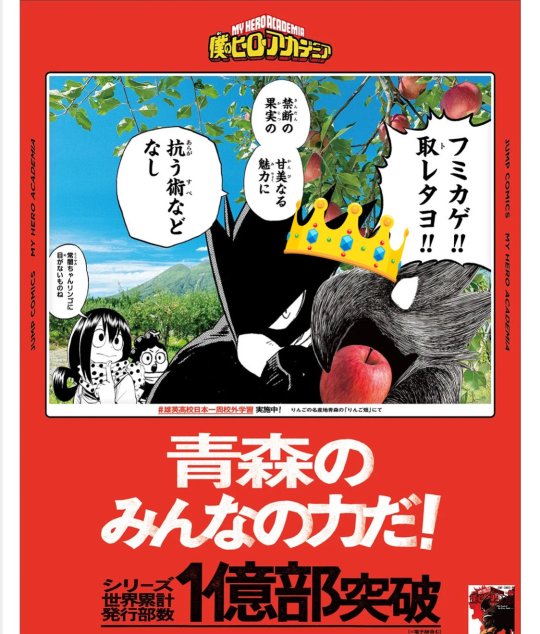
Photo credit: twitter user redaotkrsn
Dark Shadow: "Fumikage!! I GOT ONE!!"
Tokoyami: "The allure of forbidden fruit which tastes so sweet..."
Dark Shadow: "One simply cannot resist!"
Asui: "Tokoyami-chan sure likes apples, huh?"
Agriculture is huge in Aomori, and specifically they are famous for their apples, contributing about 60% of Japan's entire apple production. Raw apples, jams, juices, desserts, etc., they are everywhere in Aomori, and fyi, they are all absolutely delicious. The sweetest, richest, freshest apples I've ever had in my life were the ones I had here! Dark Shadow is right, one simply cannot resist!!!
Iwate

Photo credit: twitter user bakkk_17
Todoroki: "I can have as many bowls as I want, right?"
Endeavor: "SHOUTOOOOO!!!"
Kouda: "Todoroki-kun!! Your dad said he wants to eat with you, too!!"
Todoroki: "Check, please."
Todoroki is eating wanko soba, a specialty from Iwate where it's basically an all-you-can-eat. The soba is served in many small bowls, and you slurp them up and immediately get served more. The verb he uses, ikeru, is one people also use for "holding your liquor well," which I personally found hilarious. "Oh yeah, I can hold my noodles."
Miyagi
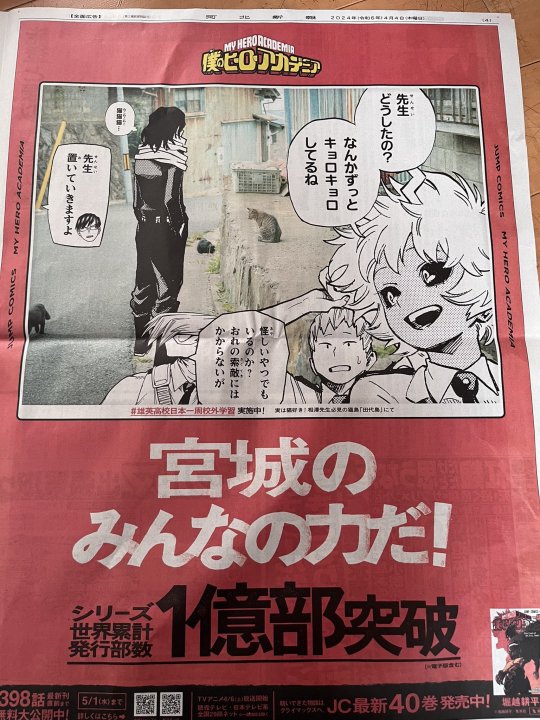
Photo credit: twitter user Abino_Haru_Maki
Ashido: "Teacher, what's wrong? You keep lollygagging about!"
Aizawa: "Kittykittykitty..."
Shouji: "Anybody suspicious around? Nothing has come up in my search for enemies."
Iida: "We're leaving you behind, teacher."
Miyagi is famous for being home to Tashirojima, the so-called "Cat Island" where cats outnumber people. Iida gets revenge!!
Akita

Photo credit: twitter user kado0730
Hagakure: "Namahage faces are so scary!!"
Kaminari: "Looks just like Bakugou, don't it."
Bakugou: "THERE'S NO RESEMBLANCE AT ALL, I'LL SEND YOU FLYING!!"
Sero: "He's a rotten kid who looks just like a Namahage!"
Namahage are frightening folkloric figures from Akita's New Year's festival. Men wear big demon masks and straw coats and wield a (fake) weapon; they march through the streets or knock on doors to scold misbehaving children, asking if there are any "warui ko," (naughty/rotten/bad kids), which is what Sero calls Bakugou.
Yamagata
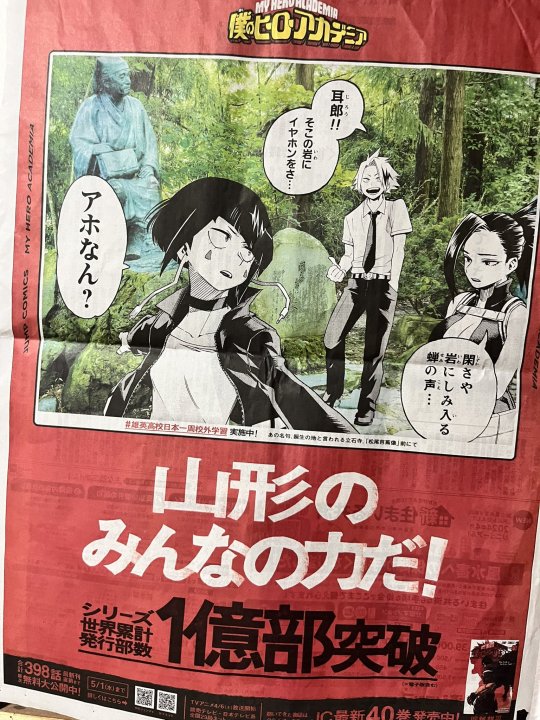
Photo credit: twitter user ha_n_a_0
Yaoyorozu: "Oh, tranquility! Penetrating the very rock, a cicada’s voice."
Kaminari: "Jirou! How about you put your earphones on that rock?"
Jirou: "Are you stupid?"
Yaoyorozu is reciting a famous poem by Basho Matsuo written when he visited the Buddhist temple, Risshaku-ji (also called Yamadera, meaning "mountain temple"). This translation is by Helen Craig McCullough. Risshaku-ji, a National Historic site, is home to a number of beautiful buildings and statues built into the mountainside; temple history claims a lineage back to the 9th century. The trail up to the temple consists of 1,015 steps; I visited in winter, which made it quite the precarious climb!
Fukushima

Photo credit: twitter user kingyo0927
Kirishima: "This right here is what I should be aiming for!!"
Aoyama: "A fateful encounter~!"
Bakugou: "When I said 'just being able to keep standing through anything makes you crazy strong,' this ain't what I meant!!"
Kirishima is looking at rows of okiagari koboshi, which are traditional papier-mâché dolls popular in Fukushima's western Aizu region. They are weighted so that no matter what you do to them, they pop right back up to standing!
That's all for Day 1! I'm still translating Day 2 and collecting Day 3's as they roll in, so please look forward to those. :D
131 notes
·
View notes
Text

#2023 Photos#Agricultural Field Photos#Agriculture Photos#Branch - Plant Part Photos#Close-up Photos#Crop - Plant Photos#Cultivated Photos#Farm Photos#Food Photos#Freshness Photos#Fruit Photos#Grape Photos#Green Color Photos#Growth Photos#Leaf Photos#Nature Photos#No People Photos#Outdoors Photos#Photography Photos#Plant Photos#Plant Stem Photos#Red Photos#Tomato Photos#Unripe Photos#Vegetable Photos#Vertical Photos#Vine - Plant Photos
0 notes
Text

#my photos#photooftheday#photograph#picture#photography#photoshoot#photographer#photoshop#photo#field#grass#trees#meadow#meadowcore#fields#plant#agriculture#sweden#scandinavia#beautiful nature#nature#landscape#landscape photography#landscape photoshoot#landscape photoset#nature photography#nature lovers#nature images#mother nature#forest
17 notes
·
View notes
Text

#late fall#fields#agriculture#wheat field#stormy weather#clouds#dreary#my photos#photography#canon camera#old
1 note
·
View note
Text
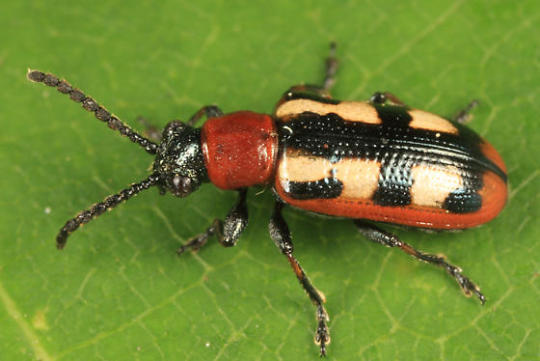


Spare a Moment for the Asparagus Beetle
Crioceris asparagi, more often known as the common asparagus beetle, is a species native to Europe and Asia; is has also been introduced to North America. As the name implies, it is almost exclusively found on asparagus plants, making it a common sight in agricultural fields and grasslands with wild asparagus.
The common asparagus beetle is easy to spot, due to its distinctive markings. Both males and females are black, with a red thorax and a red ring around their wing casings (elytra). Each individual also has three large, white or cream spots on each of their elytra. But for all their flashy markings, C. asparagi are quite small, reaching only 7 mm (0.28 in) in length.
The bright markings of the asparagus beetle are thought to mimic those of another type of stinging beetle, as a way to deter predators. However, this defense is not very effective, as C. asparagi are a popular food for birds including ducks and chickens, as well as larger beetles and wasps. If its bright coloration fails to ward off threats, the beetle will flee to another plant or play dead. For its part, the asparagus beetle only feeds on one thing: asparagus.
Breeding for C. asparagi occurs in April or May and lasts throughout the spring. Males court females by riding on their abdomens and guarding them from other males; females in turn will often attempt to avoid male attention by moving away or kicking them. A female will often mate with several males, and only retains the sperm of the male she prefers. Following copulation, she lays 4-8 eggs on the underside of an asparagus leaf. The eggs can take anywhere from three to twelve days to hatch, and the larvae immediately begin feeding on their host plant. After several weeks, during which time the larvae go through for molting periods or instars, they pupate and emerge as adults. Several generations can occur in a single season. When the weather grows colder, the asparagus beetle burrows into the soil or leaf litter to hibernate through the winter. Most adults only live about a year or so.
Conservation status: The common asparagus beetle has a large, robust population and has not been evaluated by the IUCN. In both its native and introduced range, it is often considered a pest for asparagus farmers.
If you send me proof that you’ve made a donation to UNRWA or another organization benefiting Palestinians– including esim donations– I’ll make art of any animal of your choosing.
Photos
Tom Murray
David Gould
Phil Myers
#common asparagus beetle#Coleoptera#Chrysomelidae#leaf beetles#beetles#insects#arthropods#urban fauna#urban arthropods#grasslands#grassland arthropods#europe#asia#north america#animal facts#biology#zoology#ecology
94 notes
·
View notes
Text

@melissaabroad, I dug up some old photos! I've seen a few in a neighborhood of Western Tokyo with a lot of agricultural fields but not really elsewhere in the city? They sell local produce and sometimes potted plants.


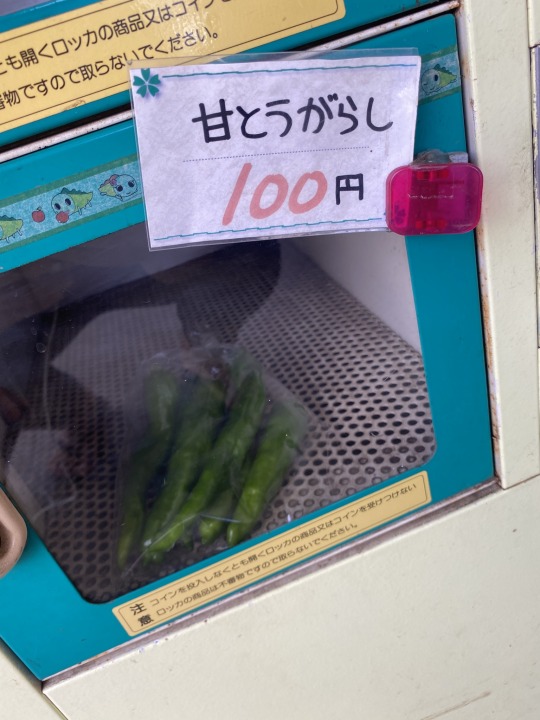

They're pretty low-tech "machines" and only take exact change. Sometimes the farmer will make change for you, sometimes they're far from the farm and you're on your own. Oh, also, it seems like the price is set per cubbyhole and can't be changed—if they want to sell a cabbage for ¥250, they put it in a ¥300 cubby with a ¥50 coin taped to it.
They have a calendar up listing what items they expect and when. When I've bought unusual vegetables there, they sometimes come with recipe ideas. The food prices are generally comparable to normal supermarket veggies, sometimes cheaper, but the quality is fresher or comparable to organic. The plant prices are usually cheap, and they generally do surprisingly well? At least the herbs have.
The disadvantage is that you can't really rely on them. Selection is limited and unpredictable, they tend to sell out early, and they pull down the shutters at 7pm. But idk, even when I end up missing out, their existence makes me happy! They were a good destination for my shitty pandemic walks in 2020. They will make you smile.
(Referencing this post)
221 notes
·
View notes